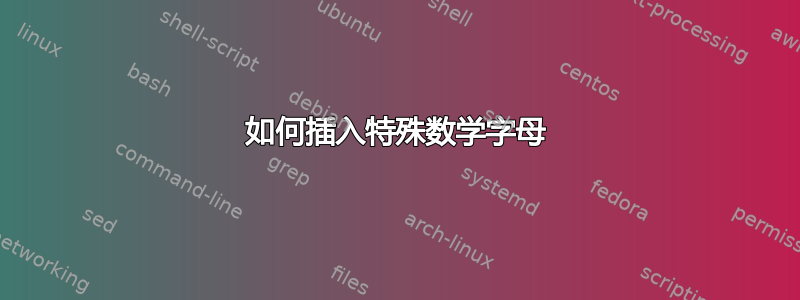
我正在尝试在名为“腔体精细度”的物理量方程中插入一个特殊的数学字母。它基本上由一个花哨的字母 F 表示,看起来就像图片中显示的那样。(参考:http://mirrors.ctan.org/macros/latex/contrib/mathalpha/doc/mathalpha-doc.pdf)。
经过一番研究,我似乎需要下载一个数学包才能使用它,但大多数数学包都不是免费的。我只需要这个包中的一个字母,而且可能只会用到几次。有没有什么简单的方法可以插入它?
我\mathcal{F}现在正在使用(如下图所示),但它看起来不太好。
答案1
例如,使用默认的 TeX 安装,您可以生成以下任何内容(以及其他选项):

代码如下:
\documentclass{article}
\usepackage[T1]{fontenc}
\DeclareFontFamily{T1}{calligra}{}
\DeclareFontShape{T1}{calligra}{m}{n}{<->s*[1.44]callig15}{}
\DeclareMathAlphabet\mathcalligra {T1}{calligra} {m} {n}
\DeclareMathAlphabet\mathzapf {T1}{pzc} {mb} {it}
\DeclareMathAlphabet\mathchorus {T1}{qzc} {m} {n}
\DeclareMathAlphabet\mathrsfso {U}{rsfso}{m}{n}
\begin{document}
\Huge
\noindent
$\mathzapf{F}$\marginpar{Zapf}\\
$\mathchorus{F}$\marginpar{tgchorus}\\
$\mathcalligra{F}$\marginpar{calligra}\\
$\mathrsfso{F}$\marginpar{rsfso}\\
\end{document}
答案2
该dutchcal软件包使 dutchcal 字体随时可用。它们源自 esstix 字体,这是一种类似 times 的字体,略作了修改。如果您使用的是 MiKTeX,在使用 MiKTeX 软件包管理器安装它们后,您通常需要启动updmap才能使字体完全可用。
\documentclass{article}
\usepackage{dutchcal}
\begin{document}
$ \mathcal{F}\enspace \mathbcal{F}$
\end{document}
 还有一个
还有一个bickham包,但是让字体真正可用于您的 TeX 系统则更加复杂,因为 Bickham 是一种 opentype 字体,必须使用 LCDF Type Tools 将其转换为 type 1。
答案3
\mathcal{F}您也可以尝试使用提供的版本\usepackage{F}。在我看来,这会给出更令人愉悦的书法字体:

代码:
\documentclass[]{article}
\usepackage{eucal}
\begin{document}
% eucal redefines \mathcal command but keeps original
% Computer Modern version available as \CMcal
$\CMcal{F}$ Original \verb!\mathcal{F}!
$\mathcal{F}$ \verb!\mathcal{F}! with \verb!eucal!
\end{document}
有关详细信息,请参阅For more info, see\mathcal{F} 字符有两个不同版本吗?。
答案4
在 Unicode 系统字体样本(通过包访问unicode-math)中,符号形状的卷曲程度有多种:
梅威瑟:
\documentclass[12pt]{article}
\usepackage{xcolor}
\pagecolor{red!3}
\usepackage{unicode-math}
\setmathfont{XITS Math}[Colour=blue]
\setmathfontface\masana{Asana Math}
\setmathfontface\mdejavu{DejaVu Math}
\setmathfontface\mtgdeja{TeX Gyre DejaVu Math}
\setmathfontface\mpagella{TeX Gyre Pagella Math}
\setmathfontface\mbonum{TeX Gyre Bonum Math}
\setmathfontface\mschola{TeX Gyre Schola Math}
\setmathfontface\mtermes{TeX Gyre Termes Math}
\setmathfontface\mlatin{Latin Modern Math}
\setmathfontface\mcambria{Cambria Math}
\setmathfontface\mfira{Fira Math}
\setmathfontface\mfreeserif{FreeSerif}
\setmathfontface\mlibert{Libertinus Math}
\setmathfontface\mnoto{Noto Sans Symbols}
\setmathfontface\mqui{Quivira}
\setmathfontface\mstixtwo{STIX Two Math}
\setmathfontface\mstixgen{STIXGeneral}
\setmathfontface\msymbola{Symbola}
\setmathfontface\mgaramond{\detokenize{Garamond-Math}}
\newcommand\mfsize{\Huge}
\setmainfont{Noto Serif}
%mas = Mathematical Alphanumeric Symbols block in unicode
\newcommand\themassym{ℱ}
\begin{document}
\section {Sampling {\mfsize $\symcal{F}$}}%symbol name comes from unicode-math-table.tex
This is script {\mfsize $\symcal{F}$} (unicode Letterlike Symbols U+2131) in math mode:
\vspace{24pt}
\begin{tabular}{rccl}
XITS Math & \mfsize $\themassym$ & \mfsize $\mcambria \themassym$ & Cambria Math \\
\ &\ & \ & \ \\
Asana Math & \mfsize $\masana {\themassym}$ & \mfsize $\mfira \themassym$ & Fira Math (no script series)\\
\ &\ & \ & \ \\
DejaVu Math & \mfsize $\mdejavu \themassym$ & \mfsize $\mfreeserif \themassym$ & FreeSerif \\
\ &\ & \ & \ \\
Tex Gyre Bonum Math & \mfsize $\mbonum \themassym$ & \mfsize $\mlibert \themassym$ & Libertinus Math \\
\ &\ & \ & \ \\
Tex Gyre DejaVu Math & \mfsize $\mtgdeja \themassym$ & \mfsize $\mnoto \themassym$ & Noto Sans Symbols \\
\ &\ & \ & \ \\
Tex Gyre Pagella Math & \mfsize $\mpagella \themassym$ & \mfsize $\mqui \themassym$ & Quivira \\
\ &\ & \ & \ \\
Tex Gyre Schola Math & \mfsize $\mschola \themassym$ & \mfsize $\mstixtwo \themassym$ &STIX Two Math \\
\ &\ & \ & \ \\
Tex Gyre Termes Math & \mfsize $\mtermes \themassym$ & \mfsize $\mgaramond \themassym$ & Garamond-Math \\
\ &\ & \ & \ \\
Latin Modern Math & \mfsize $\mlatin \themassym$ & \mfsize $\msymbola \themassym$ & Symbola \\
\end{tabular}
\end{document}





